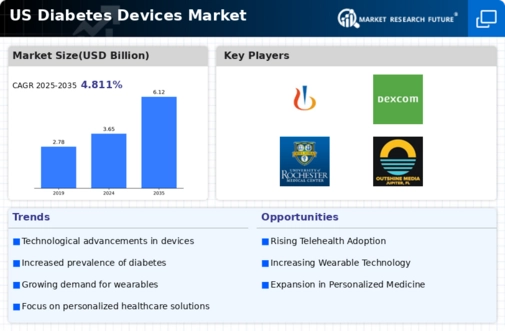Rising Prevalence of Diabetes
The increasing prevalence of diabetes in the United States is a primary driver for the diabetes devices market. According to the Centers for Disease Control and Prevention (CDC), approximately 34.2 million Americans, or 10.5% of the population, have diabetes. This growing patient population necessitates the development and adoption of advanced diabetes management devices. As the number of individuals diagnosed with diabetes continues to rise, the demand for devices such as continuous glucose monitors (CGMs) and insulin pumps is expected to increase significantly. The diabetes devices market is projected to expand as healthcare providers seek effective solutions to manage this chronic condition, ultimately improving patient outcomes and reducing healthcare costs associated with diabetes-related complications.
Growing Awareness and Education
Growing awareness and education regarding diabetes management are crucial factors driving the diabetes devices market. Public health campaigns and educational programs have increased knowledge about diabetes prevention and management strategies. As individuals become more informed about the importance of monitoring blood glucose levels and adhering to treatment plans, the demand for diabetes devices is likely to rise. Healthcare providers are also emphasizing the need for regular monitoring, which further propels the market. The diabetes devices market is expected to benefit from this heightened awareness, as patients actively seek out tools that facilitate better management of their condition, leading to improved health outcomes.
Innovations in Device Technology
Innovations in technology are transforming the diabetes devices market, leading to the development of more efficient and user-friendly products. Recent advancements include the integration of artificial intelligence and machine learning into diabetes management devices, which enhance data analysis and personalized treatment plans. For instance, smart insulin pens and automated insulin delivery systems are gaining traction among patients. The market for diabetes devices is expected to grow as these innovations improve the accuracy and convenience of diabetes management. Furthermore, the introduction of mobile applications that sync with devices allows for real-time monitoring and data sharing with healthcare professionals, thereby fostering better patient engagement and adherence to treatment regimens.
Supportive Reimbursement Policies
Supportive reimbursement policies play a vital role in the growth of the diabetes devices market. Insurance coverage for diabetes management devices, including CGMs and insulin pumps, has expanded in recent years, making these technologies more accessible to patients. The Centers for Medicare & Medicaid Services (CMS) has recognized the importance of these devices in managing diabetes, leading to increased reimbursement rates. This financial support encourages patients to invest in advanced diabetes management tools, thereby driving market growth. As reimbursement policies continue to evolve, the diabetes devices market is likely to experience further expansion, as more individuals gain access to essential devices that improve their quality of life.
Aging Population and Lifestyle Changes
The aging population in the United States, coupled with lifestyle changes, is a significant driver of the diabetes devices market. As individuals age, the risk of developing diabetes increases, leading to a higher demand for diabetes management solutions. Additionally, lifestyle factors such as poor diet and lack of physical activity contribute to the rising incidence of diabetes. The diabetes devices market is expected to grow as healthcare providers seek effective tools to manage this chronic condition among older adults. Furthermore, the increasing prevalence of obesity, a major risk factor for diabetes, underscores the need for innovative devices that assist in monitoring and managing blood glucose levels effectively.















Leave a Comment